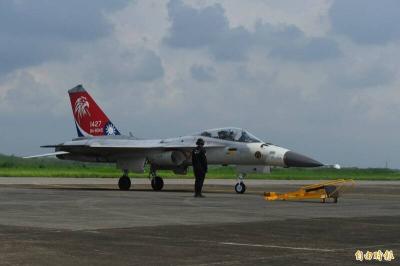Beijing is developing a variety of "credible military options" to prevent Taiwan from achieving independence, including tools to discourage the US from coming to the Taipei's aid in a conflict with China, the US Department of Defense warned in a new report.
They have been fueled lately by President Chen Shui-bian's (
According to the Pentagon survey, Chinese political leaders as well as commanders of the People's Liberation Army (PLA) are not remaining idle in the face of these challenges.
"The PLA's offensive capabilities improve each year and provide Beijing with an increasing number of credible options to intimidate and actually attack Taiwan," the department said in its annual report on China's military might sent to Congress at the end of the week.
China's arsenal arrayed against Taiwan includes approximately 500 short-range ballistic missiles deployed in Nanjing military district.
If equipped with adequate guidance systems, these missiles could destroy key leadership facilities, military bases and communication and transportation nodes with minimal advanced warning, Pentagon analysts point out.
Some of these weapons are believed to be capable of hitting US military bases in Okinawa.
Taiwan still maintains a qualitative edge over China in air power, boasting three times as many modern so-called "fourth-generation" fighter jets as China. But Beijing is working hard to close the gap.
China's air force now has nearly 3,400 aircraft, and its share of fourth-generation planes, mainly Su-27 and Su-30 fighter-bombers purchased from Russia, is increasing steadily, the report pointed out.
"Over the next several years, given current trends, China most likely will be able to cause significant damage to all of Taiwan's airfields and quickly degrade its ground-based air defenses and associated command and control," the document warned.
Ground forces targeting Tai-wan include three army groups in Nanjing that include a plethora of special operations units.
But the Pentagon believes Bei-jing would have trouble mounting a D-Day-style invasion of Taiwan "throughout the remainder of the decade" primarily because of its lack of a credible amphibious lift capability.
Chinese military planners believe the US will likely come to Taiwan's rescue in case of its showdown with China, according to the report. To counter US aid, the Chinese military are likely to use naval mines, submarine and cruise missile to attack a US aircraft carrier.
It may even resort to high-altitude nuclear blasts in the hope that its electromagnetic effects would interrupt communications and jam radars, the Pentagon warned.
The report contains sharp criticism of Taiwan's army, which it says "has major shortcomings in training and reservist mobiliza-tion." Naval operations "are not well integrated with those of the army and air force, and multi-mission training is infrequent," it said.
The report is like to spark calls for larger US military assistance to Taiwan in Congress.
A pro-Taiwan amendment has already been introduced in a US$422.2 billion defense authorization bill that passed the House of Representatives earlier this month. The amendment, sponsored by Representative Jim Ryun, calls for senior military officer exchanges with Taipei.

LOW RISK: Most nations do not extradite people accused of political crimes, and the UN says extradition can only happen if the act is a crime in both countries, an official said China yesterday issued wanted notices for two Taiwanese influencers, accusing them of committing “separatist acts” by criticizing Beijing, amid broadening concerns over China’s state-directed transnational repression. The Quanzhou Public Security Bureau in a notice posted online said police are offering a reward of up to 25,000 yuan (US$3,523) for information that could contribute to the investigation or apprehension of pro-Taiwanese independence YouTuber Wen Tzu-yu (溫子渝),who is known as Pa Chiung (八炯) online, and rapper Chen Po-yuan (陳柏源). Wen and Chen are suspected of spreading content that supported secession from China, slandered Chinese policies that benefit Taiwanese and discrimination against Chinese spouses of

ALIGNED THINKING: Taiwan and Japan have a mutual interest in trade, culture and engineering, and can work together for stability, Cho Jung-tai said Taiwan and Japan are two like-minded countries willing to work together to form a “safety barrier” in the Indo-Pacific region, Premier Cho Jung-tai (卓榮泰) yesterday said at the opening ceremony of the 35th Taiwan-Japan Modern Engineering and Technology Symposium in Taipei. Taiwan and Japan are close geographically and closer emotionally, he added. Citing the overflowing of a barrier lake in the Mataian River (馬太鞍溪) in September, Cho said the submersible water level sensors given by Japan during the disaster helped Taiwan monitor the lake’s water levels more accurately. Japan also provided a lot of vaccines early in the outbreak of the COVID-19 pandemic,

PROMOTION: Travelers who want a free stopover must book their flights with designated travel agents, such as Lion Travel, Holiday Tours, Cola Tour and Life Tours Air Canada yesterday said it is offering Taiwanese travelers who are headed to North America free stopovers if they transit though airports in Japan and South Korea. The promotion was launched in response to a potential rise in demand for flights to North America in June and July next year, when the US, Canada and Mexico are scheduled to jointly host the FIFA World Cup, Air Canada said. Air Canada offers services to 13 of the 16 host cities of the tournament’s soccer games, including Toronto and Vancouver; Mexico City, Guadalajara and Monterrey in Mexico; Atlanta, Georgia; Boston; Dallas; Houston;

The US approved the possible sale to Taiwan of fighter jet spare and repair parts for US$330 million, the Pentagon said late yesterday, marking the first such potential transaction since US President Donald Trump took office in January. "The proposed sale will improve the recipient's capability to meet current and future threats by maintaining the operational readiness of the recipient's fleet of F-16, C-130," and other aircraft, the Pentagon said in a statement. Trump previously said that Chinese President Xi Jinping (習近平) has told him he would not invade Taiwan while the Republican leader is in office. The announcement of the possible arms